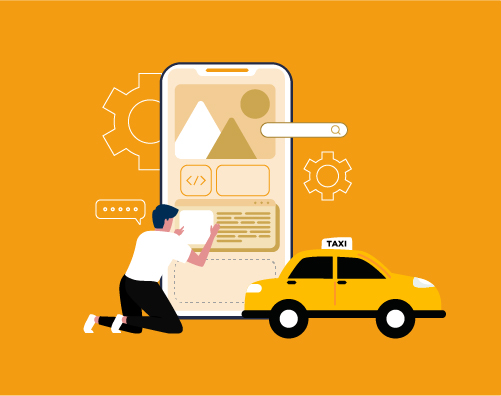How to Build a Ride-Sharing App Like Uber: Features, Tech & Cost Estimation


The ride-sharing industry has revolutionized the way we think about transportation, making it easier, faster, and more affordable to travel from one place to another. Apps like Uber, Lyft, and other similar platforms have disrupted traditional taxi services, offering users unparalleled convenience through mobile technology. In fact, the demand for Uber-like apps has skyrocketed, with entrepreneurs looking to replicate this success in various markets around the world.
If you’re considering building an Uber-like app, whether to enter the ride-sharing industry or create a new transportation solution, it’s essential to understand both the technical and financial aspects involved. A well-developed app can provide seamless experiences for users and drivers while offering robust backend systems for administration and management.
In this blog, we’ll explore the key steps involved in building an Uber-like app, from conceptualization and design to development, deployment, and beyond. We’ll also dive into the cost breakdown, helping you understand how much it would take to bring your idea to life and what factors influence the final price. Whether you’re a startup or an established business looking to expand, this guide will give you valuable insights into the process and costs of building your own Uber-like app.
Let’s dive into the details of creating an app that could revolutionize how people get around!
An Uber-like app is a mobile application that enables users to book rides from drivers in real-time, typically through a seamless interface. The concept of an Uber-like app isn’t limited to just transportation—it has evolved to include food delivery services, parcel deliveries, and even pet transportation, replicating the ride-sharing model in various sectors.
At its core, an Uber-like app consists of three main components:

This is the interface that users (passengers) interact with. They can book rides, track drivers, and make payments through the app. Some core features include:
This is where drivers interact with the platform. It includes features like:
The admin panel is used for managing all activities across the platform. Key features include:
In essence, an Uber-like app is designed to connect users with service providers (drivers) in real-time, ensuring efficiency, convenience, and satisfaction for both parties. It’s a business model that thrives on ease of use, reliability, and real-time interactions, which is why it’s become a successful and scalable approach across multiple industries.
To successfully build an Uber-like app, it’s essential to integrate a range of key features that cater to both passengers and drivers, while also ensuring seamless backend management for administrators. These features contribute to the user experience and the functionality of the platform. Here’s a breakdown of the most critical features:

Passengers need an easy way to sign up, either through their email, phone number, or social media accounts. The app should allow users to manage their profile, including personal details, payment information, and preferences (e.g., ride type, payment method).
This is the core functionality of the app, enabling passengers to book a ride instantly or schedule it for a later time. The interface should be simple, allowing users to enter their pickup and drop-off locations, select a ride type (e.g., economy, premium), and view estimated costs before confirming the booking.
Passengers should be able to track the driver’s location in real-time. This feature uses GPS technology to show the driver’s proximity and estimated arrival time, offering both convenience and safety to passengers.
After the ride is completed, passengers need a secure and convenient way to pay for their trip. Payment gateways such as Stripe or PayPal allow integration of multiple payment methods, including credit/debit cards, mobile wallets (e.g., Apple Pay, Google Pay), and cash options.
Once the ride is completed, passengers can rate the driver and provide feedback. This ensures quality control and allows both drivers and passengers to build trust and reliability on the platform.
The app should maintain a history of past rides, including dates, routes, and payment details. Additionally, notifications for ride status, cancellations, and promotions can be sent to passengers to keep them informed.
Like passengers, drivers must sign up and create a profile. The app should allow drivers to upload necessary documents (e.g., driver’s license, vehicle insurance) for verification and set their availability status (e.g., online/offline).
When a passenger books a ride, drivers should receive a real-time notification with all the ride details: pickup location, destination, fare estimate, and route. This ensures that drivers can respond promptly to incoming requests.
GPS integration is crucial for drivers to navigate to the passenger’s location and the destination. The app should provide real-time navigation with the shortest and most efficient route, factoring in traffic conditions and road closures.

The admin panel should allow platform operators to manage user data (both drivers and passengers) and monitor real-time ride activities. Admins can review and resolve issues such as cancellations, complaints, and disputes.
Admins should have access to financial data, including driver payouts, passenger payments, and platform earnings. Detailed financial reports help in auditing, tracking profits, and planning for business growth.
Admins can send important notifications to users, such as service updates, promotions, or system maintenance alerts. This keeps the platform transparent and ensures smooth communication with both drivers and passengers.
Building an Uber-like app requires a carefully selected technology stack that supports scalability, security, real-time communication, and smooth user experience. The right tech stack helps in building a robust app that can handle high traffic, real-time updates, and seamless integration with other services. Here, we’ll explore the essential components of a tech stack for building an Uber-like app.
The frontend of your Uber-like app is the face of the platform, where users (both passengers and drivers) interact with the application. It should be intuitive, responsive, and quick to load, ensuring users have a smooth experience.
The backend is where the business logic of your Uber-like app runs. It’s responsible for managing databases, processing payments, handling ride requests, and integrating with other services.
Third-party services and APIs are essential for enhancing the functionality of an Uber-like app. Here are some crucial integrations:
The admin panel is a web-based dashboard that helps the platform owner manage and monitor the app’s activities. It provides access to user management, financial reporting, analytics, and other administrative functions. Technologies commonly used for building an admin panel include:
Security is paramount in an Uber-like app, especially when dealing with personal data, payment information, and sensitive location tracking. Here are some security measures to implement:
Your Uber-like app must be built to handle scaling as it grows in terms of users and ride requests. Some key considerations for scalability include:
Here’s a concise table summarizing the cost breakdown for building an Uber-like app:

Building an Uber-like app comes with unique technical and operational challenges. However, with the right approach, these hurdles can be strategically overcome. Below are five major challenges along with practical solutions:
Challenge: GPS glitches, poor network areas, and device limitations can affect location accuracy and trip tracking.
Challenge: Inefficient matching leads to longer wait times and poor user experience.
Challenge: Handling multiple payment methods while ensuring secure transactions.
Challenge: The system must handle thousands of simultaneous bookings, especially during peak times.
Challenge: Navigating diverse legal landscapes across different regions or countries.
Building an Uber-like app goes far beyond replicating ride-booking features—it requires a strategic approach to design, development, scalability, and user experience. That’s where BizBrolly becomes your ideal tech partner. With proven expertise in developing real-time, location-based applications, BizBrolly offers end-to-end development services—from idea validation and intuitive UI/UX design to robust backend architecture, seamless integrations, and post-launch support. Our solutions are secure, scalable, and tailored to your business goals, using modern technologies like React Native, Node.js, and AWS. Whether you’re a startup aiming to disrupt local transport or an enterprise entering the mobility space, BizBrolly ensures your product is built for performance, security, and growth. We also offer transparent pricing and deep industry insights to help you make smart decisions at every stage. Let’s bring your Uber-like app idea to life—connect with BizBrolly today for a free consultation and start your journey toward building the next big thing in on-demand mobility.

In recent years, artificial intelligence (AI) has rapidly advanced, with neural ...
Explore more
Cloud computing is transforming the manufacturing industry by making it easier t...
Explore more


D-23, Sector 63, Noida,
UP - 201307

141 Westgate Dr, Edison,
NJ - 08820

4 Black lion court, Mill road, Kent, UK – ME71HL

2207, 2220 Lakeshore Blvd W, Toronto ON- M8V0C1

94A Central Road, Jacanlee, Johannesburg 2194